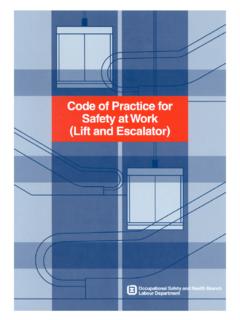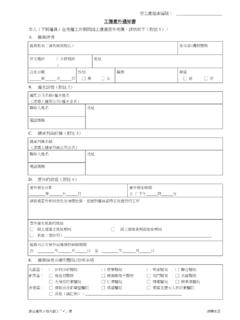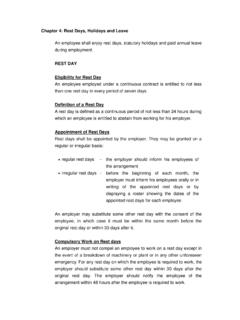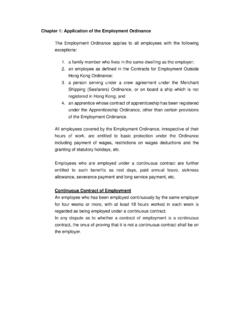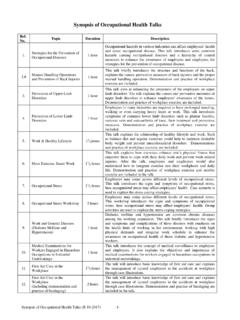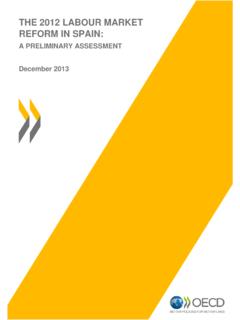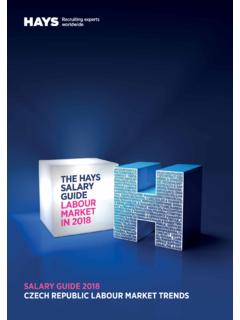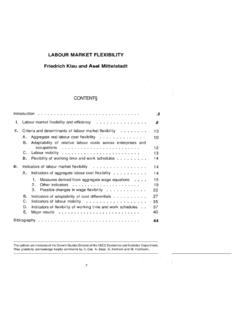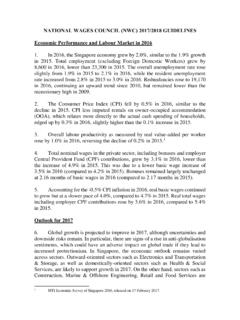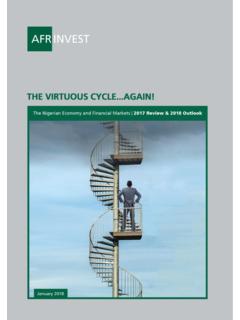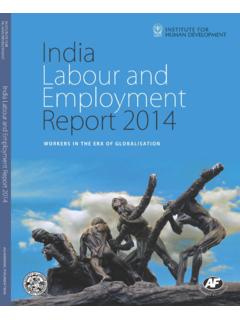Transcription of Printed by the Government Logistics Department - …
1 Printed by the Government Logistics DepartmentReport of the Policy Study on Standard Working Hours Table of Content Table of Content Page Executive Summary 1 Part I Background Chapter 1 Introduction 15 Concerns over Working Hours Situation in Hong Kong 15 Objective of the Policy Study 17 Scope of the Policy Study 17 Way Forward 19 Chapter 2 Regulatory Framework in Hong Kong 20 Introduction 20 Regulations on Employment of Children and Young Persons 21 Occupational Safety and Health 24 Other Categories of Employees 24 Comments 27 Part II Experience in Other Places Chapter 3 Overview of Global Working Hours Situation 28 International Labour Conventions on Hours of Work 28 Global Working Hours Regulations 30 Comments 33 Chapter 4 Study of Working Hours Regimes in Other Places 35 Introduction 35 Working Hours Limit 36 Overtime Limit and Overtime Pay 37 Exemptions 38 Flexibility Arrangements 39 Rest Period 39 Comments 41 Report of the Policy Study on Standard Working Hours Table of Content Chapter 5 Observations on Regime Design 42
2 Definition of Working Hours 42 Objectives of Working Hours Policy 47 Standard Working Hours vs Maximum Working Hours 51 Exemptions 54 Flexibility Arrangements 60 Chapter 6 Implementation Experience in Other Places 68 A Politicised and Lengthy Process of Consensus Building 68 Disputes over Key Legal Definitions 75 Employees Benefits vs Public Service and Business Flexibility 79 Possible Wage Reduction Resulting from Shorter Working Hours 82 Enforcement Challenges 84 Chapter 7 Impact on the Labour Market and Working Hours Situation 88 Implications for Small and Medium Enterprises 88 Impact on Actual Working Hours 93 Impact on the Labour Market and General Economy 97 Relationship between Standard Working Hours and Statutory Minimum Wage 102 Part III Hong Kong: Economic Implications and Impact Assessment Chapter 8 Working Hours in Hong Kong.
3 A Macroeconomic Perspective 106 Macroeconomic Backdrop 106 Development in the Labour Market and Its Connection with Long Working Hours 109 Working Hours as a Shock Absorber and Source of Economic Growth 114 Comments 117 Report of the Policy Study on Standard Working Hours Table of Content Chapter 9 Overview of the Working Hours Situation in Hong Kong 118 Components of Working Hours and Available Surveys 118 Compensated Working Hours 120 Uncompensated Overtime Hours 127 Estimated Total Working Hours 129 Working Hours and Wages 132 Employees and Sectors with Long Working Hours 133 Working Hours in Small and Medium Enterprises 135 Comments 136 Chapter 10 Economic Implications and Impact Assessment 138 Implications for the Overall Economy and Labour Market 138 Impact on Businesses: a Broad-brush Cost Impact Assessment 144 Impact on Employees Income.
4 Illustrative Examples 149 Comments 156 Part IV Issues to be Considered Chapter 11 Key Issues to be Considered 157 Introduction 157 Issues to be Considered 157 Comments 162 Part V Way Forward Chapter 12 The Next Step Forward 164 Appendices 1 Average Usual Weekly Hours Worked on the Main Job by Full-time Employment in Countries of the Organisation for Economic Co-operation and Development, 2000-2010 165 2 Working Hours Regulation in 12 Economies 166 3 Working Hours Statistics Data Sources.
5 Methodology and Limitations 263 4 Statistical Appendix of Distribution of Working Hours 268 Report of the Policy Study on Standard Working Hours Table of Content 5 Methodology of Cost Impact Assessment 285 6 Statistical Appendix of Cost Impact Assessment 287 7 A List of Questions to be Further Examined in Relation to the Implementation of a Working Hours Regime in Hong Kong 302 Abbreviations 308 Glossary 310 References 316 Report of the Policy Study on Standard Working Hours Executive Summary P. 1 EXECUTIVE SUMMARY Introduction Acknowledging the concerns in the community over the working hours situation in Hong Kong, the Government announced in both the 2010-11 and 2011-12 Policy Addresses that subsequent to the enactment of the Minimum Wage Ordinance (Cap.)
6 608), it would embark on a policy study on standard working hours (SWH) to lay the foundation for an informed public discussion on the matter. The Labour Department (LD) was assigned the task and has now completed the policy study. This report aims to provide a solid and objective basis for an informed and in-depth discussion on this important and controversial subject and stimulate exchange of opinions among stakeholders and people from different sectors. The discussion will in the end shed light on the optimal future policy direction, and facilitate the Government in mapping out the way ahead.
7 The policy study was undertaken on three fronts. First, LD studied the systems and experience of other places in regulating working hours (Part II of the Report). Second, the Census and Statistics Department collected statistics on the latest working hours situation of employees in various sectors of Hong Kong. Third, the Economic Analysis and Business Facilitation Unit of the Financial Secretary s Office analysed the data collected to assess the possible impact of introducing SWH in Hong Kong (Part III of the Report). Towards the end of the report (Part IV), we will identify a number of key issues that need to be discussed in depth among employees, employers and the community at large in exploring the way forward.
8 Regulatory Framework in Hong Kong To allow employees days off for taking rest, the Employment Ordinance (EO) (Cap. 57) has specifically provided for rest days, statutory holidays and paid annual leave. Currently, there is no general statutory provision for standard or maximum working hours, overtime limits or Report of the Policy Study on Standard Working Hours Executive Summary P. 2overtime pay in Hong Kong. Employers and employees are at liberty to negotiate the terms and conditions of employment provided that such terms and conditions meet the relevant requirements set down in the EO and other relevant legislation.
9 An employee whose employment contract provides for overtime pay is protected by the EO against unlawful deduction or defaults. Overtime pay is also included in the calculation of various employee s entitlements. [Paragraph ] While there is no general statutory provision for standard or maximum working hours, there are specific regulations under the EO to regulate the working hours of children (under the age of 15) and young persons (aged 15 or above and below 18) working in industrial undertakings, covering the daily working hours, daily rest break, etc.
10 To protect employees from working prolonged hours without rest, the Government also proactively promotes the importance of providing appropriate rest breaks for employees and published a Guide on Rest Breaks . Certain types of work or occupations are subject to working hours regulation, either in the form of statutory notice ( security personnel), or through occupation-specific guidelines promulgated by Government authorities ( franchised bus captains and green minibus drivers). [Paragraphs to ] Overview of Global Working Hours Situation Working hours regulation could be traced back to the industrial revolution in the 18th-19th century.

